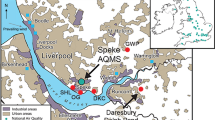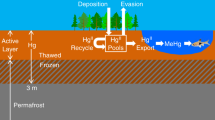Abstract
Persistent organic pollutants (POPs) are organic compounds produced by human activities that are resistant to environmental degradation. They include industrial chemicals, such as polychlorinated biphenyls, and pesticides, such as dichlorodiphenyltrichloroethane. Owing to their persistence in the environment, POPs are transported long distances in the atmosphere, accumulating in regions such as the Arctic, where low temperatures induce their deposition1,2. Here the compounds accumulate in wildlife and humans, putting their health at risk1,3,4. The concentrations of many POPs have decreased in Arctic air over the past few decades owing to restrictions on their production and use. As the climate warms, however, POPs deposited in sinks such as water and ice are expected to revolatilize into the atmosphere5, and there is evidence that this process may have already begun for volatile compounds6. Here we show that many POPs, including those with lower volatilities, are being remobilized into the air from repositories in the Arctic region as a result of sea-ice retreat and rising temperatures. We analysed records of the concentrations of POPs in Arctic air since the early 1990s and compared the results with model simulations of the effect of climate change on their atmospheric abundances. Our results indicate that a wide range of POPs have been remobilized into the Arctic atmosphere over the past two decades as a result of climate change, confirming that Arctic warming could undermine global efforts to reduce environmental and human exposure to these toxic chemicals.
This is a preview of subscription content, access via your institution
Access options
Subscribe to this journal
Receive 12 print issues and online access
$209.00 per year
only $17.42 per issue
Buy this article
- Purchase on Springer Link
- Instant access to full article PDF
Prices may be subject to local taxes which are calculated during checkout



Similar content being viewed by others
References
Macdonald, R. W., Harner, T. & Fyfe, J. Recent climate change in the Arctic and its impact on contaminant pathways and interpretation of temporal trend data. Sci. Total Environ. 342, 5–86 (2005).
Mackay, D. & Wania, F. Transport of contaminants to the Arctic: partitioning, processes and models. Sci. Total Environ. 160/161, 25–38 (1995).
Macdonald, R. W., Mackay, D. & Hickie, B. Contaminant amplification in the environment: Revealing the fundamental mechanisms. Environ. Sci. Technol. 36, 456A–462A (2002).
Kraemer, L. D., Berner, J. E. & Furgal, C. M. The potential impact of climate on human exposure to contaminants in the Arctic. Int. J. Circumpolar Health 64, 498–508 (2005).
Nizzetto, L. et al. Atlantic Ocean surface waters buffer declining atmospheric concentrations of persistent organic pollutants. Environ. Sci. Technol. 44, 6978–6984 (2010).
Hung, H. et al. Atmospheric monitoring of organic pollutants in the Arctic under the Arctic Monitoring and Assessment Programme (AMAP): 1993–2006. Sci. Total Environ. 408, 2854–2873 (2010).
Zhang, L. & Lohmann, R. Cycling of PCBs and HCB in the surface ocean-lower atmosphere of the open Pacific. Environ. Sci. Technol. 44, 3832–3838 (2010).
Li, Y-F. et al. Polychlorinated biphenyls in global air and surface soil: Distributions, air–soil exchange, and fractionation effect. Environ. Sci. Technol. 44, 2784–2790 (2010).
Meyer, T., Lei, Y. D., Muradi, I. & Wania, F. Organic contaminant release from melting snow, 1. Influence of chemical partitioning. Environ. Sci. Technol. 43, 657–662 (2009).
Wong, F. et al. Air–water exchange of anthropogenic and natural organohalogens on International Polar Year (IPY) Expeditions in the Canadian Arctic. Environ. Sci. Technol. 45, 876–881 (2011).
Gioia, R. et al. Polychlorinated biphenyls in air and water of the North Atlantic and Arctic Ocean. J. Geophy. Res. Atmos. 113, D19302 (2008).
Becker, S. et al. Long-term trends in atmospheric concentrations of α- and γ-HCH in the Arctic provide insight into the effects of legislation and climatic fluctuations on contaminants levels. Atmos. Environ. 42, 8225–8233 (2008).
Hung, H. et al. Temporal and spatial variabilities of atmospheric polychlorinated biphenyls (PCBs), organochlorine (OC) pesticides and polycyclic aromatic hydrocarbons (PAHs) in the Canadian Arctic: Results from a decade of monitoring. Sci. Total Environ. 342, 119–144 (2006).
Steele, M., Ermold, W. & Zhang, J. Arctic Ocean surface warming trends over the past 100 years. Geophys. Res. Lett. 35, L02614 (2008).
Yue, S. & Wang, C. Y. Regional streamflow trend detection with consideration of both temporal and spatial correlation. Int. J. Climatol. 22, 933–946 (2002).
Gao, H., Ma, J., Cao, Z., Dove, A. & Zhang, L. Trend and climate signals in seasonal air concentration of organochlorine pesticides over the Great Lakes. J. Geophys. Res. 115, D15307 (2010).
Li, Y. F. & Bidleman, T. F. Correlation between global emissions of α-hexachlorocyclohexane and its concentrations in the arctic air. J. Environ. Inform. 1, 52–57 (2003).
Stroeve, J., Holland, M. M., Meir, W., Scambos, T. & Serreze, M. Arctic sea ice decline: Faster than forecast. Geophys. Res. Lett. 34, L09501 (2007).
Zhang, L., Ma, J., Venkatesh, S., Li, Y. F. & Cheung, P. Modeling evidence of episodic intercontinental long-range transport of lindane. Environ. Sci. Technol. 42, 8791–8797 (2008).
Ma, J. & Cao, Z. Quantifying the perturbations of persistent organic pollutants induced by climate change. Environ. Sci. Technol. 44, 8567–8573 (2010).
Hansen, K. M., Halsall, C. J. & Christensen, J. H. A dynamic model to study the exchange of gas-phase persistent organic pollutants between air and a seasonal snowpack. Environ. Sci. Technol. 40, 2644–2652 (2006).
Meyer, T. & Wania, F. Organic contaminant amplification during snowmelt. Water Res. 42, 1847–1865 (2008).
Lamon, L. et al. Modeling the global levels and distribution of polychlorinated biphenyls in air under a climate change scenario. Environ. Sci. Technol. 43, 5818–5824 (2009).
Arctic Monitoring and Assessment Programme Arctic Pollution 2009 (AMAP, 2009); available at http://www.amap.no.83.
Pachauri, R. & Reisinger, A. in IPCC Climate Change 2007: Synthesis Report (Cambridge Univ. Press, 2007); available at http://www.ipcc.ch/publications_and_data/publications_and_data_reports.shtml.
Su, Y. et al. Spatial and seasonal variations of hexachlorocyclohexanes (HCHs) and hexachlorobenzene (HCB) in the Arctic atmosphere. Environ. Sci. Technol. 40, 6601–6607 (2006).
Bidleman, T. F. et al. Sources, Occurrence, Trends and Pathways in the Physical Environment. Canadian Arctic Contaminants Assessment Report II (Northern Contaminants Program 2004); available at http://www.ainc-inac.gc.ca/nth/ct/ncp/pubs/phy/phy-eng.asp.
Zhang, Y., Tao, S., Shen, H. & Ma, J. Inhalation exposure to ambient polycyclic aromatic hydrocarbons and lung cancer risk of Chinese population. Proc. Natl Acad. Sci. USA 106, 21063–21067 (2009).
Ma, J, Daggupaty, S, Harner & Li, T. Impacts of lindane usage in the Canadian prairies on the Great Lakes ecosystem—1: Coupled atmospheric transport model and modeled concentrations in air and soil. Envion. Sci. Technol. 37, 3774–3781 (2003).
Jantunen, L. M. & Bidleman, T. F. Reversal of the air–water gas exchange direction of hexachlorocyclohexanes in the Bering and Chukchi Seas: 1993 versus 1988. Envion. Sci. Technol. 29, 1081–1089 (1995).
Kanamitsu, M. et al. NCEP-DOE AMIP-II Reanalysis (R-2). Bull. Am. Meteor. Soc. 83, 1631–1643 (2002).
Acknowledgements
This study is funded by the Government of Canada Program for International Polar Year (project of the Intercontinental Atmospheric Transport of Anthropogenic Pollutants to the Arctic). B. Yu provided the IPCC multimodel ensemble-averaged surface air temperature data from 1901 to 2100 and Y. Su compiled the data of physical–chemical properties for the selected POPs. The authors would also like to acknowledge financial support for air measurements conducted at the Zeppelin station from the Norwegian Pollution Control Authorities (Norway) and the Alert station from the Northern Contaminants Program (Indian and Northern Affairs Canada). H.H. would like to thank Canadian Forces Station Alert for supporting the data collection.
Author information
Authors and Affiliations
Contributions
J.M. designed the research; J.M., H.H. and R.K. contributed and analysed data; C.T. carried out modelling and J.M. and H.H. wrote the manuscript.
Corresponding authors
Ethics declarations
Competing interests
The authors declare no competing financial interests.
Supplementary information
Supplementary Information
Supplementary Information (PDF 366 kb)
Rights and permissions
About this article
Cite this article
Ma, J., Hung, H., Tian, C. et al. Revolatilization of persistent organic pollutants in the Arctic induced by climate change. Nature Clim Change 1, 255–260 (2011). https://doi.org/10.1038/nclimate1167
Received:
Accepted:
Published:
Issue Date:
DOI: https://doi.org/10.1038/nclimate1167
This article is cited by
-
Substantial halogenated organic chemicals stored in permafrost soils on the Tibetan Plateau
Nature Geoscience (2023)
-
Adsorption of the hydrophobic organic pollutant hexachlorobenzene to phyllosilicate minerals
Environmental Science and Pollution Research (2022)



